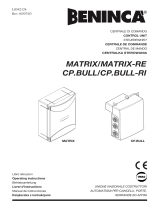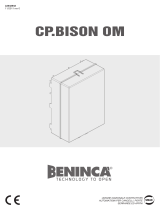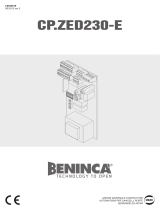Page is loading ...

L8542349
04/2008 rev 1
CP.B24
UNIONE NAZIONALE COSTRUTTORI
AUTOMATISMI PER CANCELLI, PORTE
SERRANDE ED AFFINI

2
3
F1
F10A
+
24sc
VMsc
VMtrs
24trs
0trs
0sc
-
1 2 V
1 2 V
CB.24V
D L1D L 2
N
L
15
23
20
23
0
0V
SLOW
24V
FAST
2

10
11
EC declaration of conrmity
Manufacturer: Automatismi Benincà SpA.
Address: Via Capitello, 45 - 36066 Sandrigo (VI) - Italia
Herewith declares that: control unit CP.B24.
complies with the following relevant provisions:
EMC guidelines: 89/336/CCE, 93/68/CEE
Low voltage guidelines: 73/23/CEE, 93/68/CEE
Benincà Luigi, Legal responsible.
Sandrigo, 08/04/2008.
WARNINGS
This manual has been especially written to be use by
qualied tters.
None of the information provide in this manual can be
considered as being of interest for the end users.
Preserve this manual for future needs.
The technician has to furnish all the information related to
the step by step function, the manual and the emergency
function of the operator, and to deliver the manual to the
nal user.
Foresee on the supply net an onnipolar switch or
selector with distance of the contacts equal or
superior to 3 mms.
Verify that of the electrical system there is an awry diffe-
rential interrupter and overcurrent protection.
Some typologies of installation require the connection of
the shutter to be link at a conductive mass of the ground
according to the regulations in force.
The electrical installation and the operating logic must
comply with the regulations in force.
The leads fed with different voltages must be physically
separate, or they must be suitably insulated with additional
insulation of at least 1 mm.
The leads must be secured with an additional xture near
the terminals.
During installation, maintenance and repair, interrupt the
power supply before opening the lid to access the electri-
cal parts
Check all the connections again before switching on the
power.
The unused N.C. inputs must be bridged.
The descriptions and the present illustrations in this manual
are not binding. Leaving the essential characteristics of
the product unchanged, the manufacturer reserves himself
the right to bring any change of technical, constructive
or commercial character without undertaking himself to
update the present publication.
TECHNICAL DATA
Contol unit supply
24 Vdc
Power supply
230 Vac 50/60 Hz or 115Vac 50/60Hz according to the version
Output supply
1 motor 24Vdc
Power maximum motor
120 W
Output supply accessories
24Vdc 500mA max.
Protection level
IP54
Operating temp.
-20°C / +70°C
Radio receiver
built in 433,92 MHz confgurabile (rolling-code or programmable + rolling-code)
Rolling code transmitters supported
64 rolling-code

10
11
CP.B24 CONTROL UNIT
WIRE DIAGRAM
Wire connections shown in Fig. 1 are described hereunder:
Terminals Function Description
M+/M- Motor Quick connector for motor connection, 24VDC 120W max
COM
SWO
SWC
Limit switches
Quick connector for limit switch connection.
COM: Common to limit switches
SWO: Input, OPEN limit switches (N.C. contact)
SWC: Input, CLOSE limit switches (N.C. contact)
BAR/BAR SAFETY EDGE
Input, safety edge contact
Resistive edge: Closed “DAS” jumper
Mechanical edge: Open “DAS” jumper
If the safety edge is activated, the gate stops and the performs a movement reversion
for 3s
PED PEDESTRIAN
Input, pedestrian push-button (N.O. contact). It controls the partial opening of the gate
according to the value preset by TPED.
PHOTA Open Photocell Input, photocell activated in the opening phase only
PHOT Photocell Input, photocell activated in both opening and closing phases
STOP STOP Input, STP push-button (N.C. contact)
P.P. Step-by-Step Input, step-by-step push button (N.O. contact)
+COM COMMON Common to all control inputs.
SHIELD/
ANT
Antenna
Antenna connection to the built-in receiver card
SHIELD: Shield/ ANT: Signal
FAST
24V
SLOW
0V
Secondary
Transformer
Inputs, connection of the secondary transformer
FAST: Input, 23V, it powers the motor during operation at normal speed
23V: power supply of accessories
SLOW: Input, 15V, it powers the motor during braking
0V: Input, 0V
IICH 2°Ch radio
Output, second radio channel of the built-in radio receiver.
N.O. contact, power-free.
+ 24V - 24 VAC/DC
, power supply of accessories, 24VAC/0.5A max.
CAUTION: in the event of installation of the battery loader card CB.24V, the output
(without mains power supply) will feature a voltage of 24VDC - polarised.
Check the correct connection of devices.
BLINK Flashing light Connection of the ashing light, 24VDC 15W max.
SCA SCA Open gate warning light 24Vac output.
ENCODER Encoder Connector for connection of the position optic sensor (encoder).
EMERGENCY BATTERY
In case of power failure, an optional accessory to power the control unit is available.
The kit is composed of CB.24V battery charge card and two rechargeable batteries at 12V/1,2Ah, which can be tted on
the back on the control unit container.
The CB.24V card must be connected between the secondary transformer and the 0/SLOW/24V/FAST inputs, as shown in
the diagram of Fig.2.
During mains powered operation, the DL2 green LED is switched on and the card maintains the battery charged.
If no mains power is available, the card powers the system through batteries, the DL1 red LED switches on.
A F10A fuse protects the control unit during operation with an emergency battery.
If no main power is available and batteries are down, both LED’s are switched.
The buffer battery works and progressively runs down until it reaches the value of 18V. When this value is reached, the
battery is disconnected.
During operation in case of power failure, the output, 24VAC accessories of the control unit, is polarised.

12
13
TO CHECK CONNECTIONS
Before programming the control unit, check that the motor is correctly connected:
1) Cut off power supply.
2) Manually release the gate leaf, move the same at approx. half stroke and block it again.
3) Power the system again.
4) Send a step-by-step control through a NC push-button temporarily connected to the PP input.
5) The gate leaf should open.
If not, reverse the motor connector (M+/M-) and limit switches by reversing the fasto connectors on the microswitches
and perform a new self-learning of the stroke.
6) Carry out the self-learning of the stroke and trigger thresholds, as shown hereunder in the AUTO menu.
PROGRAMMING
The programming of the various functions of the control unit is carried out using the LCD display on the control unit and
setting the desired values in the programming menus described below.
The parameters menu allows you to assign a numerical value to a function, in the same way as a regulating trimmer.
The logic menu allows you to activate or deactivate a function, in the same way as setting a dip-switch.
Other special functions follow the parameters and logic menus and may vary depending on the type of control unit or the
software release.
USE OF PROGRAMMING KEYS
Press <PG> key to gain access to the Main Menu (PAR>>LOG>>RADIO>>...). These keys can be selected by pressing +
and – keys.
Select the Main menu with <PG> key to enter the desired Function Menu .
• If <+> is pressed, the Function Menu can be scrolled from top to bottom.
• If <-> is pressed, the Function Menu can be scrolled from bottom to top.
• If <PG> key is pressed, presetting to be modied can be entered.
• The preset values can be modied by using <+> and <-> keys.
• The value is programmed if <PG> key is pressed again. The word “PRG” appears on the display.
See paragraph “Programming Example”.
NOTES:
Simultaneously pressing <+> and <-> from inside a function menu allows you to return to the previous menu without mak-
ing any changes.
Hold down the <+> key or the <-> key to accelerate the increase/decrease of the values.
After waiting 30s the control unit quits programming mode and switches off the display.
Pressing <-> with the display turned off means an impulse of P.P.
PARAMETERS, LOGICS AND SPECIAL FUNCTIONS
In the tables hereunder the single functions available in the control unit are shown.
MENU FUNCTION
MIN-MAX-(Default)
MEMO
PARAMETERS
TCA
Automatic closure time. Active with logic “TCA”= ON only.
At the end of the preset time, the control unit sends a closure control
signal.
1-240-(40s)
Tped
The stroke time of the gate leaf is adjusted during the partial opening
phase controlled by the pedestrian input.
1-99-(50%)
TSM
The gate leaf stroke during the braking phase is adjusted. 20-250-(50cm)
PMo
The anti-crash device* (amperometric sensor) operation is adjusted in the
opening phase, at normal speed.
1: maximum sensitivity - 99:minimum sensitivity.
1-99-(50%)
PMC
The anti-crash device* (amperometric sensor) operation is adjusted in the
closing phase, at normal speed.
1: maximum sensitivity - 99:minimum sensitivity.
1-99-(50%)
PSo
The anti-crash device* (amperometric sensor) operation is adjusted in the
opening phase, at reduced speed.
1: maximum sensitivity - 99:minimum sensitivity.
1-99-(50%)
PSC
The anti-crash device* (amperometric sensor) operation is adjusted in the
closing phase, at reduced speed.
1: maximum sensitivity - 99:minimum sensitivity.
1-99-(50%)
* WARNING:
An incorrect setting of these parameters may cause danger.
Please comply with regulations in force!

12
13
MENU FUNCTION
DEFAULT
MEMO
LOGICS
TCA
The automatic closure is enabled or disabled.
Off: disabled automatic closure.
On: enabled automatic closure
(ON)
IBL
The multi-at function is enabled or disabled.
On: enabled multi-at function. The P.P. (Step-by-step) impulse or the impulse
of the transmitter has no effect in the opening phase.
Off: disabled multi-at function.
(OFF)
IBCA
The PP and PED controls during the TCA are enabled or disabled.
On: PP and PED controls are disabled.
Off: PP and PED controls are enabled.
(OFF)
SCL
The rapid closure is enabled or disabled.
On: enabled rapid closure. With open gate or gate in the opening phase, the
activation of the photocell causes the automatic closure of the gate 3 sec after
its activation.
This function is enabled only with TCA:ON
Off: rapid closure disabled.
(OFF)
PP
The operating mode of the “P.P.” (Step-by Step) button and of the transmitter
is selected.
On: Operation : OPEN > CLOSE > OPEN >
Off: Operation: OPEN > STOP > CLOSE > STOP >
(OFF)
PRE
Forewarning ashing light enabled or disabled.
On: enabled forewarning ashing light. The ashing light is activated 3 sec be-
fore the motor starts.
Off: disabled forewarning ashing light.
(OFF)
HTR
The Service Man function is enabled or disabled.
On: Service Man operation.
The OPEN/CLOSE push buttons should be kept pressed for the entire operating
time.
Off: Automatic operation.
(OFF)
SLD
Raking is enabled or disabled.
On: Braking enabled.
Off: Braking disabled.
(OFF)
LTCA
The forewarning ashing light is enabled or disabled during the TCA time.
On: Flashing light enabled.
Off: Flashing light disabled.
(OFF)
CLOC
The OPEN input mode is selected.
On: OPEN input, with CLOCK function.
To be used for connection to timer for timed opening/closing. (CLOSED contact:
open gate. OPEN contact: normal operation).
Off: OPEN input, with OPEN function
(OFF)
ENC
The Encoder is enabled or disabled.
On: Encoder enabled.
Off: Encoder disabled.
(ON)
CVAR
The programmable code transmitters are enables or disabled.
On: Radio receiver enabled only for rolling-code transmitters.
Off: Receiver enabled for rolling-code transmitters and programmable code
transmitters (self-learning and DIPswitch) .
(OFF)
TREL
Check of OPEN and CLOSE relays is enabled or.
On: Check activated: if one of the 2 relays is faulty, the motor does not start and
the error message “ERR2” is displayed.
Off: no check to relays is carried out.
(OFF)
SOFT
Reduced speed starting is enabled or disabled.
On: Starting is performed at reduced speed for 2 seconds and then movement
is restored to normal speed.
Off: Reduced speed start is disabled.
(OFF)
OPCL
PP input as OPEN and PED input as CLOSED are enabled or disabled.
On: PP input is enabled as OPEN and PED input is enabled as CLOSED.
Off: PP and PED inputs are enabled with their function.
(OFF)

14
15
MENU FUNCTION
RADIO
PP
By selecting this function, the receiver is waiting for (Push) a transmitter code to be assigned to the
step-by-step function.
Press the transmitter key, which is to be assigned to this function.
If the code is valid, it will be stored in memory and OK will be displayed.
If the code is not valid, the Err message will be displayed.
2Ch
By selecting this function, the receiver is waiting for (Push) a transmitter code to be assigned to the
second radio channel.
Press the transmitter key, which is to be assigned to this function.
If the code is valid, it will be stored in memory and OK will be displayed.
If the code is not valid, the Err message will be displayed.
CLR
By selecting this function, the receiver is waiting for (Push) a transmitter code to be erased from
memory.
If the code is valid, it will be stored in memory and OK will be displayed.
If the code is not valid, the Err message will be displayed.
RTR
The receiver memory is completely erased. Conrmation is asked to the user.
MENU FUNZIONE
NMAN
The number of cycles (open+close) completed by the system is displayed.
When the push-button <PG> is pressed once, the rst 4 digits are displayed, if the push-button is
pressed once more, the last 4 digits are displayed.
E.g. <PG> 0012 >>> <PG> 3456: 123.456 cycles were performed.
auto
The self-calibration of the triggering thresholds of the anti-crash device (amperometric sensor), as well
as the stroke learning are performed.
When the <PG> push button is pressed once, the PUSH wording starts ashing. If the <PG> button
is pressed once more the self-calibration procedure starts and the PRG wording is displayed. The
gate will carry out at least 3 complete operations. At the end of this procedure, OK is displayed. This
procedure can be performed with the gate in any position.
The self-calibration procedure can be stopped at any moment with the contemporary pressure of <+>
and <->. If the procedure has no positive result, the Err message is displayed.
RES
RESET of the control unit. WARNING: This resets the control unit to the default values.
When the <PG> push-button is pressed once, the RES wording begins to ash, if the push-button
<PG> is pressed once more, the control unit is reset.
Note: neither the transmitter codes nor the position and stroked of the gate leaf will be erased from the
receiver.
STROKE LEARNING
For a correct operation of braking (with SLD logic: ON) it is essential that the stroke is memorised. This can be performed
either using the above described AUTO function or when the rst operation is completed (then carried out without inter-
ruptions) from open limit switch to close limit switch (or viceversa).
If the encoder is activated, the position of the gate leaf is stored in memory and reset also in case of power failure.
If the encoder is disabled, in case of power failure a new complete operation will be required to memorise the stroke and
reset braking.
Note: If the automatic system is released and manually operated, the following operation might not perform braking cor-
rectly. Also in this case a new complete operation will be required to reset the regular operation of the system.
EXAMPLE OF PROGRAMMING
Let us suppose it is necessary to:
- set an automatic closing time (TCA) of 100s
- activate pre-blinking
Perform the operations described below step by step:
Step Press Display Notes
1
PAR
First menu
2
TCA
First function of the rst menu
3
040
Value currently set for the function selected

14
15
4
100
Set the desired value with the <+> and <-> keys
5
PRG
The value is programmed
TCA
When programming has been made, the display goes to the function just set
6
PAR
Press <+> and <-> simultaneously to go to the higher menu
7
Log
Second menu
8
TCA
First function of the second menu
9
Pre
Press <-> several times to select PRE logic
10
OFF
Value currently set for the function selected
11
ON
Set the desired value with the <+> and <-> keys
12
PRG
The value is programmed
Pre
When programming has been made, the display goes to the function just set
13
PAR
Press <+> and <-> simultaneously to go to the higher menu and quit programming or
wait 30s.
DIAGNOSTICS
In the event of malfunctions, by pressing key + or - the status of all inputs (limit switches, control and safety) can be dis-
played. One segment of the display is linked to each input. In the event of failure it switches on according to the following
scheme.
N.C. inputs are represented by the vertical segments. N.O. inputs are represented by the horizontal segments.
ERROR MESSAGES
The control unit checks the correct operation of the safety devices. In the event of faults the following messages can be
displayed:
ERR Error : self-setting of the amperometric device or storage of remote control codes in memory.
ERR1 Error : faulty encoder.
ERR2 Error: OPEN or CLOSE relays are faulty.
/










